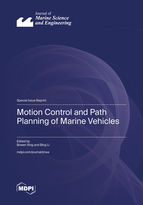Motion Control and Path Planning of Marine Vehicles
A special issue of Journal of Marine Science and Engineering (ISSN 2077-1312). This special issue belongs to the section "Ocean Engineering".
Deadline for manuscript submissions: closed (1 November 2023) | Viewed by 30330
Special Issue Editors
Interests: unmanned surface vehicles; ship motion control; path planning
Special Issues, Collections and Topics in MDPI journals
Interests: ship motion control; ship attitude control; servo control system
Special Issues, Collections and Topics in MDPI journals
Special Issue Information
Dear Colleagues,
This Special Issue focuses on the “Motion Control and Path Planning of Marine Vehicles”. Recently, more and more kinds of marine vehicles have been designed and used to explore the world, promote economic growth and protect the environment. In order to ensure the implementation of these applications, the intelligence and energy-saving property indicators of their motion control and path planning policies should be satisfied at high levels.
This Special Issue is seeking high-quality original contributions: technical papers that address the main research challenges related to the motion control and path planning of marine vehicles. Potential topics include, but are not limited to:
- Modelling and control of vessels and unmanned marine vehicles;
- Path planning of vessels and unmanned marine vehicles;
- Navigation systems of vessels and unmanned marine vehicles;
- Identification and estimation in vessels and unmanned marine vehicles;
- Cooperative and coordinated control of vessels and unmanned marine vehicle swarms;
- Unmanned marine vehicle swarm design and mission applications;
- Other control and path planning applications in marine systems.
Articles from both academia and industry are welcome. This Special Issue aims to advance the field of motion control and the path planning of marine vehicles, as well as related fields.
Dr. Bowen Xing
Prof. Dr. Bing Li
Guest Editors
Manuscript Submission Information
Manuscripts should be submitted online at www.mdpi.com by registering and logging in to this website. Once you are registered, click here to go to the submission form. Manuscripts can be submitted until the deadline. All submissions that pass pre-check are peer-reviewed. Accepted papers will be published continuously in the journal (as soon as accepted) and will be listed together on the special issue website. Research articles, review articles as well as short communications are invited. For planned papers, a title and short abstract (about 100 words) can be sent to the Editorial Office for announcement on this website.
Submitted manuscripts should not have been published previously, nor be under consideration for publication elsewhere (except conference proceedings papers). All manuscripts are thoroughly refereed through a single-blind peer-review process. A guide for authors and other relevant information for submission of manuscripts is available on the Instructions for Authors page. Journal of Marine Science and Engineering is an international peer-reviewed open access monthly journal published by MDPI.
Please visit the Instructions for Authors page before submitting a manuscript. The Article Processing Charge (APC) for publication in this open access journal is 2600 CHF (Swiss Francs). Submitted papers should be well formatted and use good English. Authors may use MDPI's English editing service prior to publication or during author revisions.
Keywords
- motion control
- path planning
- ship motion
- marine vehicle
- unmanned ocean vehicles
- autonomous
- learning and AI
- cooperation and coordination
- unmanned marine vehicle swarm







